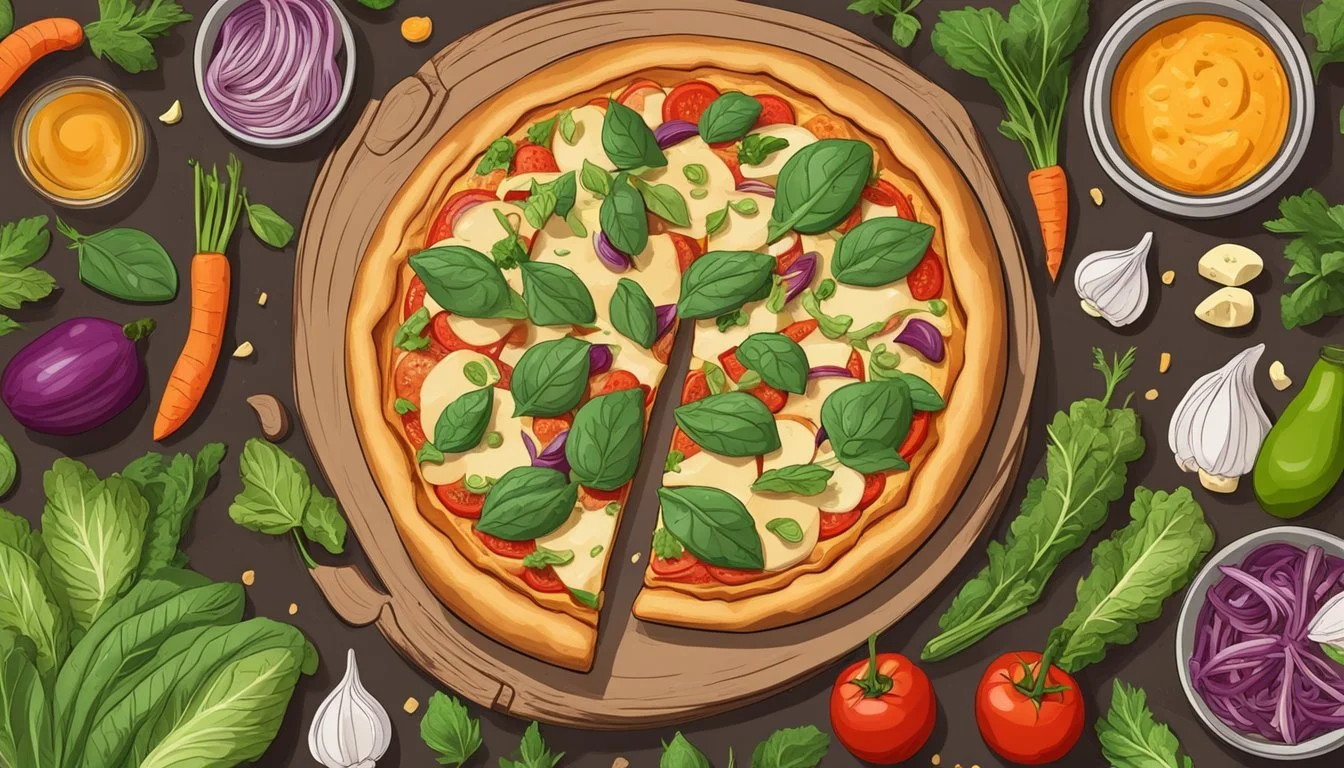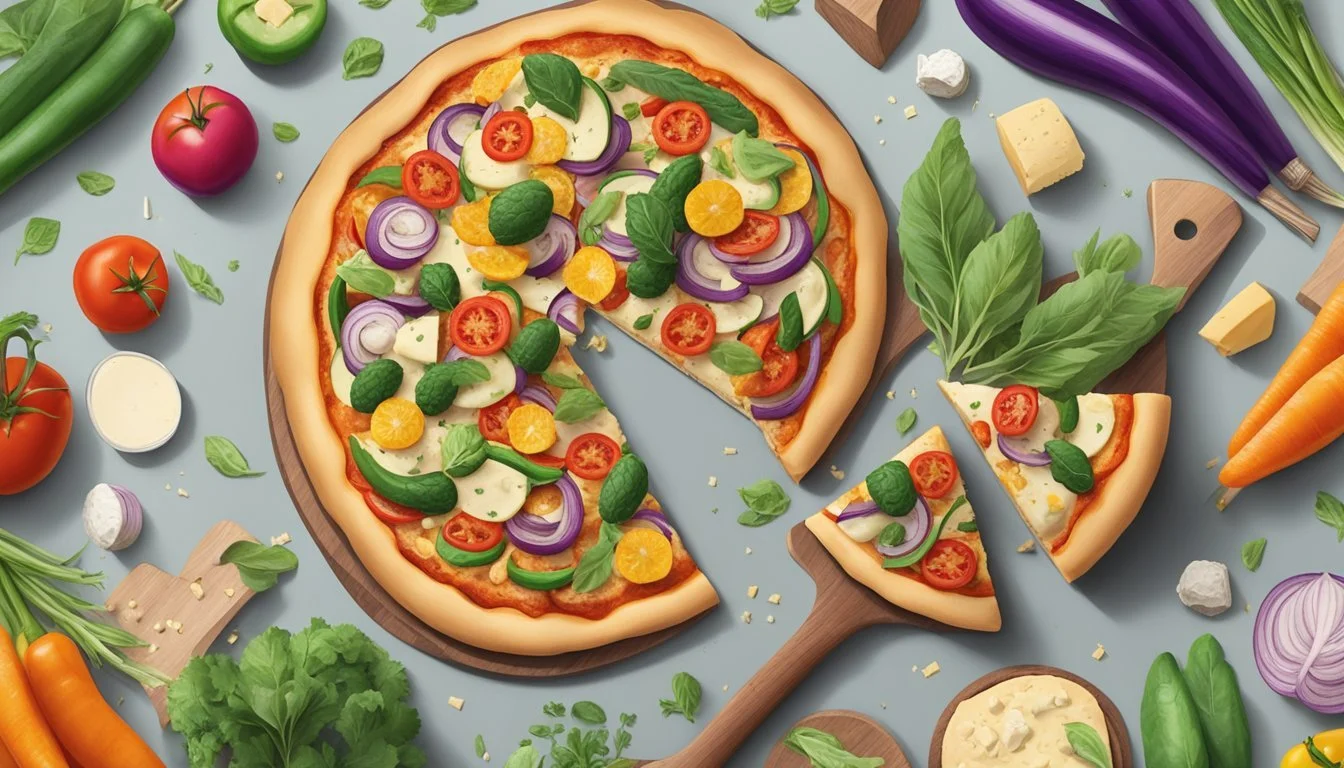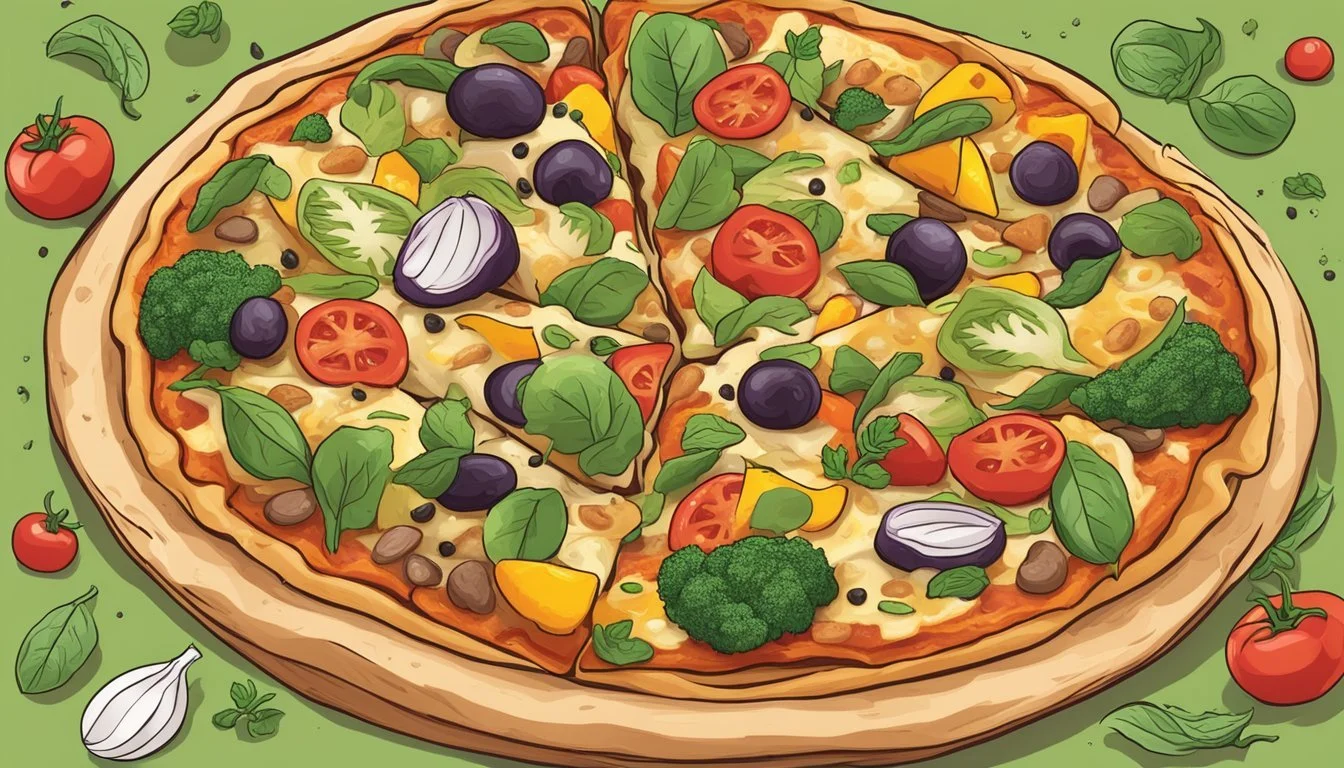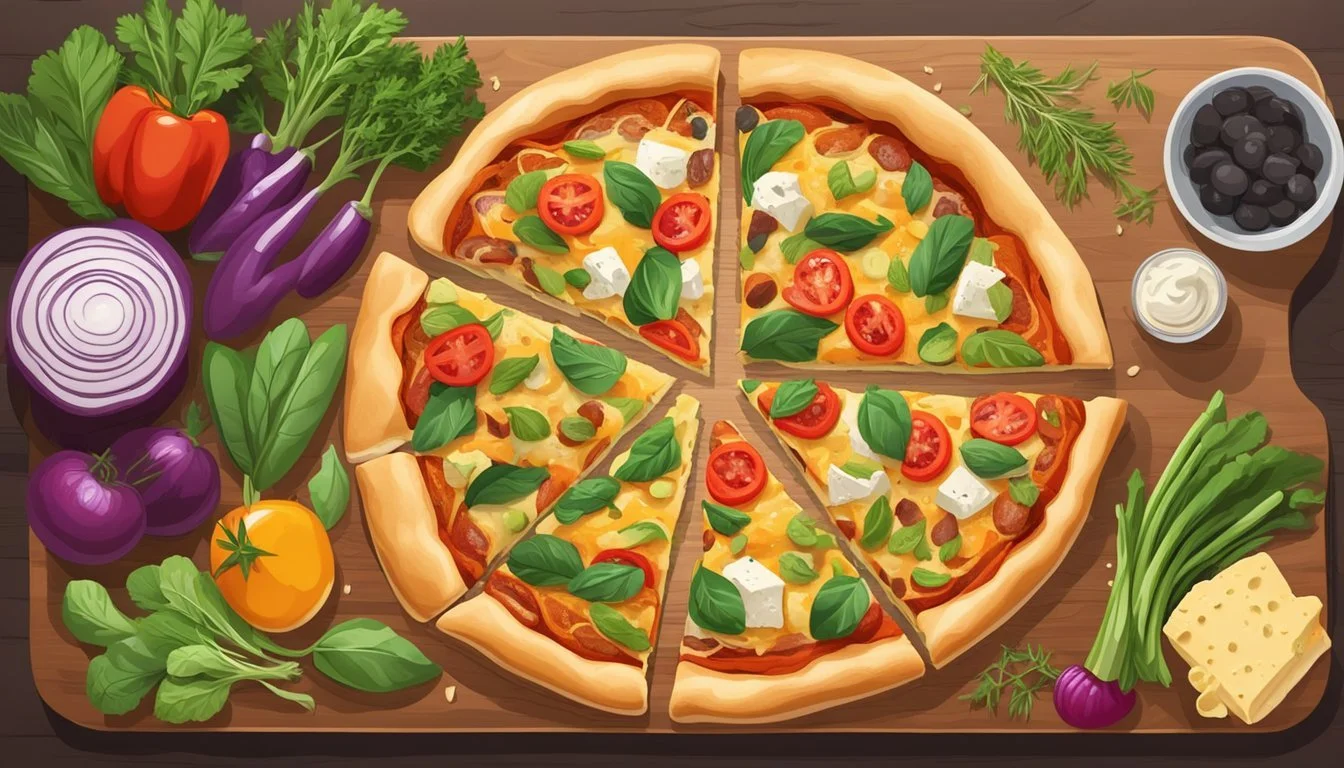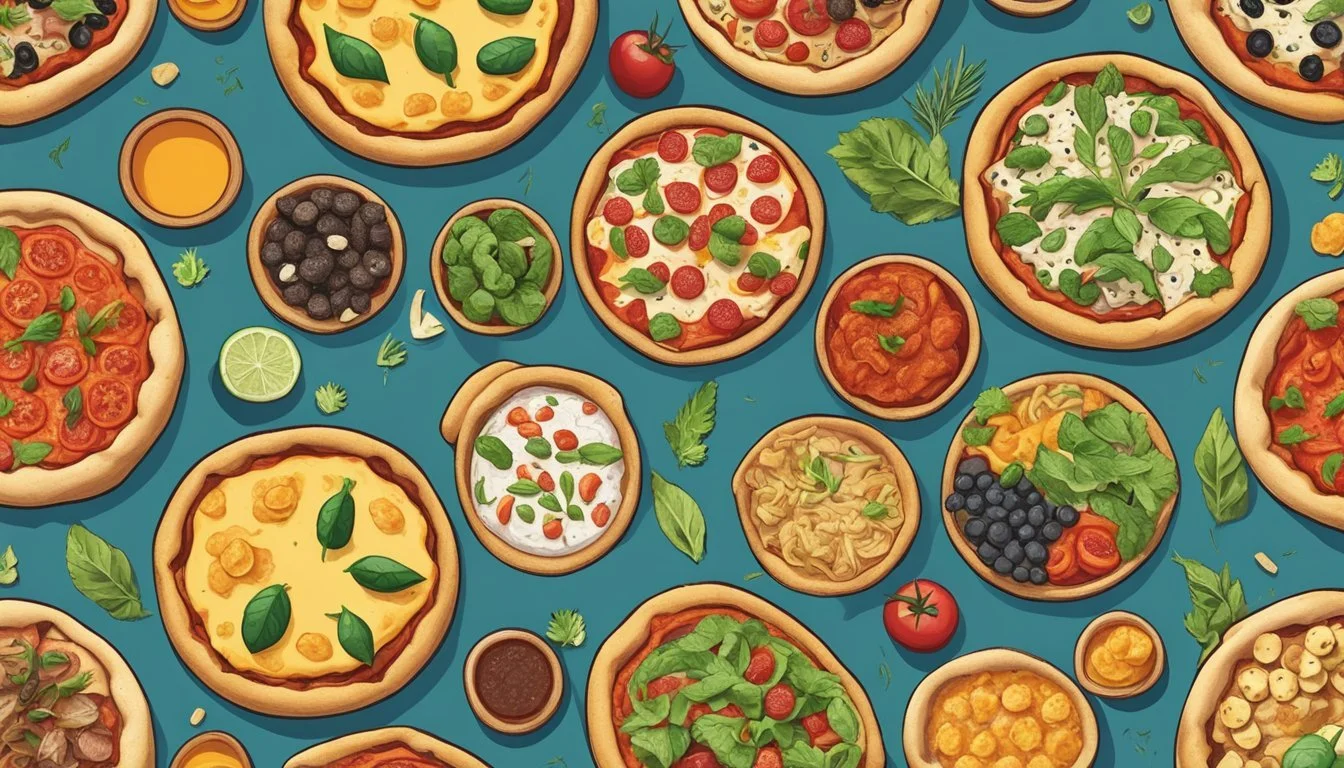Is Stuffed Crust Pizza Vegan?
Understanding Dairy-Free Options
Stuffed crust pizza (What wine goes well with pizza?) traditionally involves a ring of cheese tucked into the dough around the edges, which poses a challenge for vegans as regular cheese is a dairy product. However, with the rise in popularity of plant-based diets and the increasing availability of vegan cheese alternatives, a vegan version of stuffed crust pizza has become attainable. Vegan cheeses are usually made from nuts, soy, vegetable oils, and various starches, and they are designed to mimic the flavors and textures of traditional dairy cheese.
The approach to creating a vegan stuffed crust involves replacing all animal-derived ingredients with plant-based ones. The crust, which is typically vegan by default as it's made from flour, water, yeast, and salt, does not need modification. But attention must be paid to the stuffing and toppings, where dairy cheese is substituted with vegan cheese options. Vegan cheeses can come in forms that are easily integrated into the stuffed crust, such as shreds that melt well, or in blocks that can be sliced into strips and placed into the dough's edge. Additional vegan toppings, including a variety of vegetables, vegan meats, and sauces, can be added to complement the vegan cheese-stuffed crust, resulting in a fully plant-based pizza.
The popularity of vegan stuffed crust pizza is indicative of the broader trend toward more inclusive food options. Pizza establishments are increasingly adapting their menus to cater to vegan customers, recognizing the demand for dishes free from animal products. With the numerous vegan cheese alternatives now available, creating a delicious and satisfying vegan stuffed crust pizza is not only possible but is becoming a mainstream culinary offering. Consumers have the option to either purchase it from select pizzerias or to make it at home using readily available vegan ingredients.
Understanding Veganism
Veganism is a lifestyle choice that seeks to exclude, as far as is possible and practicable, all forms of exploitation of, and cruelty to, animals for food, clothing, or any other purpose. Individuals who adhere to a vegan diet abstain from consuming any animal products. This means that a vegan diet is plant-based and dairy-free, including no meat, dairy, eggs, or honey.
Vegans opt for alternatives derived from plants and avoid foods produced using animals or animal by-products. Vegan food typically involves a rich variety of fruits, vegetables, legumes, nuts, seeds, and grains. Veganism often extends beyond diet, encompassing a philosophy that rejects the commodity status of animals.
In the context of vegan food options, like a stuffed crust pizza, traditional ingredients are replaced with plant-based versions. For instance:
Cheese: Vegan pizzas use dairy-free cheese, often made from nuts, soy, or plant oils.
Crust: The dough is typically vegan, but it's crucial to confirm that no dairy or eggs are used as binding agents.
Toppings: These can include an array of vegetables, fruits, and meat substitutes like tempeh or textured vegetable protein.
Plant-based does not always equate to vegan, as some plant-based diets might still include small amounts of animal products. However, 'vegan' implies a stricter adherence to avoiding all animal-derived ingredients. Therefore, for a stuffed crust pizza to be considered vegan, every element, from the dough to the toppings, must be free of animal products.
Stuffed Crust Pizza Overview
Stuffed crust pizza offers a distinctive twist on traditional pizza with its cheese-encased edges, providing a hearty and indulgent experience. This section delves into the origins of this popular variety and the typical components that make up a traditional stuffed crust pizza.
History of Stuffed Crust Pizza
The concept of stuffed crust pizza emerged in the early 1990s, revolutionizing the pizza industry. It was an innovation aimed at appealing to cheese lovers and those who desired more than just a standard pizza crust. This new style quickly gained popularity, as it offered an additional layer of flavor and texture to the conventional pizza-eating experience.
Traditional Ingredients
Key components of a traditional stuffed crust pizza include:
Dough: A base typically made from a high-gluten flour to provide the necessary elasticity for wrapping the cheese.
Cheese: Mozzarella is the standard choice for its excellent melting properties and mild flavor, which complements various toppings.
Toppings: Ranging from vegetables to meats, these are added on top of the sauce-covered dough.
The process of making stuffed crust pizza involves placing strips of cheese along the periphery of the dough and then folding the dough edges over the cheese to envelop it. Upon baking, the cheese melts, creating a gooey, rich crust.
Components of Vegan Pizza
Crafting a vegan pizza demands careful selection of plant-based components that mimic the traditional pizza experience without animal products. The foundational elements include a sturdy dough, flavorful cheese alternatives, and an array of fresh toppings.
Vegan Pizza Dough
A good pizza begins with its base. Vegan pizza dough contains flour, water, and yeast as standard ingredients. A touch of olive oil and sea salt enhances the flavor and texture. To prepare, one combines these ingredients and allows the dough to rise until it doubles in size. The dough should be hand-stretched or rolled out, providing the perfect canvas for toppings.
Ingredients for Vegan Pizza Dough (Standard Recipe):
Flour: High-protein content (e.g., bread flour) for chewiness.
Yeast: Active dry yeast, a natural leavening agent.
Water: Lukewarm to activate yeast.
Olive Oil: Adds moisture and helps develop a crisp crust.
Sea Salt: For flavor enhancement.
Vegan Cheese Alternatives
The cheese in vegan pizza usually comes from plant-based substitutes such as cashew nuts or soy. These alternatives are designed to melt and stretch in a similar fashion to traditional cheese. One can sprinkle vegan parm on top of the pizza for an added flavor boost. Vegans also sometimes create cheese alternatives from tapioca or agar-agar, delivering the desired consistency.
Types of Vegan Cheese:
Cashew-based cheese: Creamy texture perfect for spreading.
Soy-based cheese: Widely available and melts well.
Store-bought vegan cheese shreds: Convenient for quick preparation.
Plant-Based Toppings
To finish the pizza, chefs adorn the cheese-laden base with a multitude of vegan toppings. Options like onion, mushrooms, spinach, kale, (What wine goes well with kale?) and green peppers not only add a pop of color but also various textures and flavors. The pizza is usually sauced with a marinara sauce, its tangy and robust flavor profile complements the subtle taste of the vegan cheese and dough.
Popular Vegan Toppings:
Onions: Sweet or red onions, thinly sliced.
Mushrooms: Adds umami and a meaty texture.
Leafy Greens: Spinach and kale for nutrient-rich layers.
Bell Peppers: Sliced for a sweet and crunchy bite.
Combining these vegan components creates a pizza that satisfies the traditional pizza experience while adhering to plant-based dietary choices.
Making Vegan Stuffed Crust Pizza
Crafting a vegan stuffed crust pizza involves specific recipes and baking techniques tailored to achieve a delicious result without any animal products. The process must accommodate both the unique properties of vegan cheese and the performance of the dough in a hot oven.
Vegan Stuffed Crust Recipe
For the stuffed crust:
Prepare vegan pizza dough by combining flour, yeast, sugar, salt, water, and olive oil, kneading until it forms a smooth and elastic ball.
Roll the dough into a circle approximately 30cm in diameter.
Place vegan cheese strips—made from ingredients such as cashews, tapioca flour, and nutritional yeast—around the edge of the dough, leaving a small margin.
Fold the edges of the dough over the cheese, sealing it by pressing down firmly.
Ingredients for the topping:
Tomato sauce (seasoned with herbs like oregano and basil)
Sautéed vegetables (mushrooms, onions, kale)
Additional shredded vegan cheese
Optional: vegan pepperoni or other plant-based meats
Prep time: 20 minutes
Total time (prep + cook time): roughly 40 minutes
Baking Techniques
To bake a stuffed crust vegan pizza:
Preheat the oven to 475°F (245°C) with a pizza stone inside.
If a stone is not available, grease a pizza pan with olive oil and lightly dust with cornmeal or place parchment paper on a baking sheet to prevent sticking.
Once the oven is at temperature, place the prepared pizza on the stone or in the pan.
Bake for 17 to 20 minutes until the crust turns golden brown.
If necessary, broil for an additional 1 to 2 minutes to brown the top of the pizza.
After baking, let the pizza cool for a few minutes before slicing.
Using these methods will ensure that the vegan stuffed crust cooks properly and the cheese has the desired melty texture.
Customizing Your Vegan Pizza
Crafting a vegan pizza affords flexibility whether one opts for scratch-made dough or the convenience of store-bought options. With a plethora of plant-based toppings, creating a delectable pie that caters to vegan preferences is simple and rewarding.
Homemade vs. Store-Bought Dough
When one considers the pizza dough, the choice between homemade and store-bought options depends on time and skill level. A homemade dough allows for complete control over ingredients, ensuring the avoidance of animal products and additives. The process is relatively easy to make, typically requiring flour, water, yeast, a bit of sugar to activate the yeast, and a pinch of salt. On the other hand, store-bought pizza dough is a convenient time-saver for those looking to streamline their cooking process. One must carefully read labels to confirm the dough is free of animal-derived ingredients.
Creative Vegan Topping Ideas
The true artistry in vegan pizza comes alive with the toppings. Start with a robust pizza sauce, which can range from a tomato sauce base seasoned with garlic powder, onion powder, and black pepper, to a rich cheese sauce made from ingredients like nutritional yeast and cashews for depth of flavor. Toppings such as sauteed mushrooms add umami and texture, and a variety of vegan cheeses—from store-bought shreds to homemade mozzarella**—melt** beautifully to create that signature pizza experience. For an added dimension of zest, a splash of lemon juice over greens like spinach or kale provides a bright counterpoint to the rich flavors.
Experiment with different combinations of the following toppings for a unique pizza every time:
Vegetables: Bell peppers, artichokes, (What wine goes well with artichokes?) olives, onions
Herbs & Spices: Basil, oregano, red pepper flakes
Proteins: Marinated tofu, tempeh, vegan pepperoni
Sauces: Vegan pesto, BBQ sauce, hummus
Remember, a good pizza is about balance and personal taste—customize your toppings to suit your palate!
Common Vegan Pizza Challenges
When creating a vegan stuffed crust pizza, one of the most notable challenges encountered is replicating the characteristics of traditional cheese. This challenge primarily revolves around achieving the desired melt, stretch, and flavor that pizza enthusiasts expect.
Mimicking Cheese Melting Properties
Vegan cheeses, especially those meant to imitate mozzarella, often face scrutiny regarding their ability to melt effectively. The melting property is crucial in a stuffed crust pizza as it provides the gooey, stretchy quality associated with the dish. Dairy-free options have improved over time, but they tend to have varying melting points compared to traditional dairy cheese.
Vegan mozzarella alternatives are typically made from a variety of plant-based ingredients, including:
Nuts (such as cashews or almonds)
Coconut oil
Tapioca flour
Each ingredient plays a role in texture and flavor, but not all vegan cheese mimics the same degree of melting. Moreover, some may leave an oily residue or fail to stretch as desired.
For cheese sauce applications in vegan pizzas, ingredients like nutritional yeast and cashews are blended to achieve a creamy texture with a hint of cheesiness. However, curating a vegan cheese sauce with the right consistency to complement rather than overwhelm the pizza can be challenging. It requires precision in ingredient ratios and often a trial-and-error approach.
Pizza makers may experiment with different blends or rely on commercially available vegan cheeses to find the right balance for their stuffed crust creations. Each brand or homemade Vegan cheese variation may interact differently with heat, with factors such as fat content and moisture levels influencing the final outcome.
Nutritional Consideration of Vegan Pizzas
When it comes to vegan pizzas, particularly those with stuffed crusts, the nutritional aspects depend largely on the choice of ingredients used. Plant-based alternatives to traditional dairy cheese and meat toppings can significantly alter the nutritional profile of the pizza.
Calories and Macronutrients: Vegan cheeses are often made from nuts or soy, which means they can be high in calories and fat, though typically in heart-healthy monounsaturated and polyunsaturated fats. It's important to note that while some vegan cheeses are lower in saturated fat compared to dairy cheese, they can still be calorically dense.
Protein: Protein content in vegan pizzas might vary. Plant-based proteins such as seitan, (What wine goes well with seitan?) tofu, or legumes used as toppings can contribute to an adequate protein intake.
Fiber: Vegan stuffed crust pizzas have the potential advantage of increased fiber, especially if whole grain dough is utilized and a generous amount of vegetables are added as toppings.
Nutrient Consideration in Vegan Pizzas Protein Varied sources like tofu, seitan, and legumes. Fats Nuts and seeds in vegan cheese may contribute more monounsaturated fats. Fiber Veggie toppings and whole grain crust can significantly increase fiber. Calcium Vegan cheese may be fortified with calcium. Check the label. Vitamin B12 Often lacking in plant-based diets, look for fortified options.
They should also be aware of potential vitamin and mineral deficiencies, such as B12, which is naturally found in animal products and may need to be supplemented in a vegan diet.
However, it's crucial to read labels as processed vegan foods can still contain high levels of sodium and additives. Consumers who choose vegan stuffed crust pizzas for their health benefits should opt for those with whole food ingredients and minimal processing to maximize nutritional gain.
Serving Suggestions for Vegan Stuffed Crust Pizza
When hosting a pizza night with a focus on vegan food, it's important to offer a variety of accompaniments that complement your homemade vegan pizza. Here are some serving suggestions:
Salads:
A simple arugula salad dressed with lemon juice and olive oil.
Classic Caesar salad using vegan dressing and croutons.
Garlic breadsticks made with vegan butter and fresh garlic.
Marinated olives and artichoke hearts for a Mediterranean touch.
Dips:
Herbed cashew cheese spread.
Marinara sauce for extra dipping.
Toppings:
Roasted vegetables such as bell peppers, zucchini, and mushrooms.
Vegan pepperoni slices for an added savory flavor.
Drinks:
Chilled craft sodas or homemade iced tea.
Wine pairings with vegan-friendly labels.
Keep the presentation casual but thoughtful to encourage guests to explore different flavor combinations. Offering a variety of toppings and sides allows guests to customize their pizza experience, ensuring there is something for every palate. Always check for dietary restrictions or allergies before finalizing the menu.
For dessert, consider serving a fruit platter or vegan ice cream to round out the meal. Remember that the key is in the details, and small touches can make your homemade vegan pizza night memorable.
Popular Vegan Stuffed Crust Pizza Variations
Vegan stuffed crust pizzas offer a delightful twist on the classic that caters to plant-based dietary preferences without sacrificing the indulgent experience of a cheesey crust. Numerous variations have emerged, varying by toppings and types of vegan cheese used to recreate the experience of pizzas like those offered by Pizza Hut with a vegan-friendly stuffed crust.
Basic Vegan Mozzarella Stuffed Crust: The most traditional variation mirrors the popular Pizza Hut stuffed crust pizza, featuring a ring of vegan mozzarella tucked into the borders of the pizza dough, often accompanied by a rich tomato sauce and assorted vegetable toppings.
Herb and Garlic Infused Crust: Baked crust gains an aromatic lift with the addition of herbs such as basil and oregano, coupled with garlic infused into the dough for a flavorful bite. This can be further enhanced with a sprinkle of cornmeal on the pan to add a subtle crunch.
Specialty Toppings:
Mushroom and Caramelized Onion: A savory blend of sautéed mushrooms and sweet caramelized onions offers a hearty topping combination for those seeking depth of flavor.
Kale and Lemon Drizzle: Fresh kale, quickly sautéed, delivers a nutrient boost, while a drizzle of lemon juice before baking adds a refreshing zing.
In each version, careful attention is paid to ensure all components are vegan, substituting animal-derived ingredients with plant-based alternatives. The option to double the amount of cheese around the edges is available for enthusiasts desiring a more decadent experience, closely resembling the generous cheese filling of traditional stuffed crusts.
Conclusion
Traditional stuffed crust pizzas generally contain non-vegan ingredients, particularly in the cheese used both as a topping and within the crust itself. However, vegan stuffed crust pizza is certainly achievable by substituting dairy cheese with vegan cheese alternatives. Vegan cheese options are created from various plant-based sources like nuts, soy, or root vegetables and are designed to mimic the texture and taste of traditional cheese.
Creating a vegan recipe for stuffed crust pizza at home allows for customization in terms of toppings and the choice of vegan cheese. Home cooks often choose to enhance their pizzas with a range of vegetables, vegan meats, or seasonings. It's also possible to experiment with the dough, incorporating different flours or herbs for a unique flavor profile.
To successfully make a stuffed crust pizza vegan, individuals should ensure that all ingredients, including the dough and sauces, are free from animal products. Manufacturers are increasingly catering to vegan diets, so premade vegan crusts and vegan-friendly pizza kits are becoming more readily available, making it easier to enjoy a delicious vegan version of this popular dish.
In summary, while stuffed crust pizza is traditionally not vegan, adaptations using plant-based ingredients provide a compassionate and tasty alternative that adheres to vegan dietary practices. Consumers should always check labels for hidden animal-derived ingredients to ensure the final product is truly vegan.


